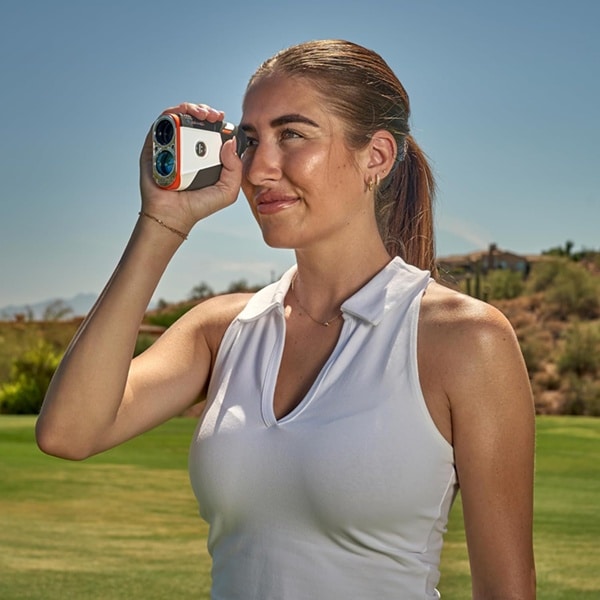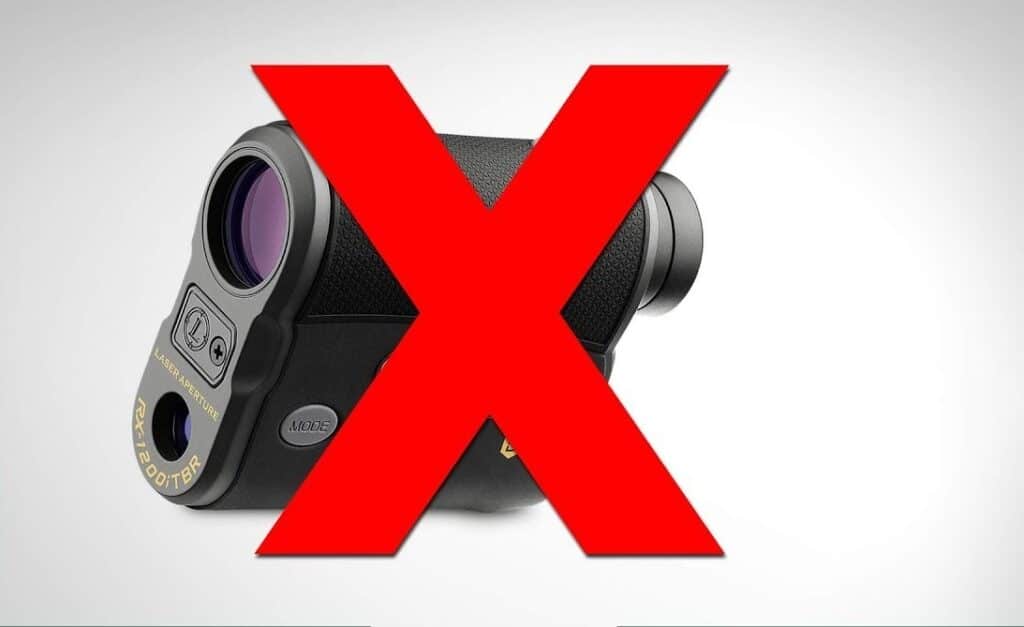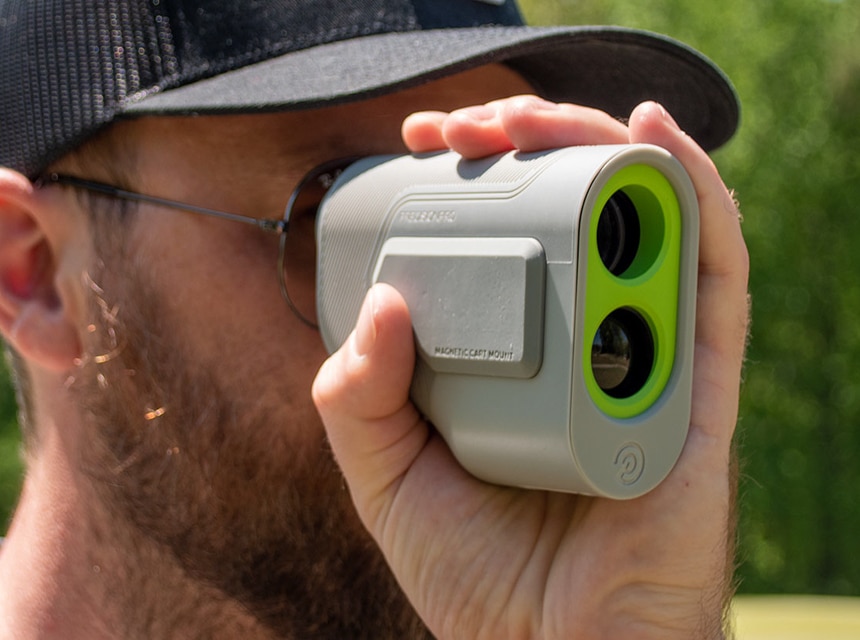

Are you thinking about adding a rangefinder to your hunting kit? Rangefinders have greatly changed the approach a lot of hunters are taking to their favorite pastime. Expert hunters agree that there are numerous benefits to using a rangefinder. But, out of the many available on the market, just which one is the best rangefinder for long range shooting?
Today we will be reviewing seven of the best long range rangefinders. We’ll be considering features such as range—so you know if it suits your methods—magnification, different modes, advanced technology and extra features. We’ll share what we liked most and what we felt could be improved.
Our handy buyers guide will give extensive details on the features you need to consider when choosing a range finder for long range shooting. The rangeviewers we’ll be reviewing are listed in the comparison table below.
More features: Intuitive display, HCD mode, LOS mode displays, scan, ranging format
The Vortex Optics Razor as it’s most commonly known gives hunters a variety of three different ranging modes. These are angle compensated horizontal component distance (HCD), Line of sight (LOS), and scan. The Impact has a black, non-illuminated LCD display and added magnification brings targets in for more accurate ranging.
An advanced LOS mode provides an option to calculate far distance and high angle shots with increased precision. Tracking a moving target becomes easier with the scan feature because it provides continuous range readings. Panning across a landscape is also a lot easier with this feature.
A regular CR2 battery is standard and battery life is always on display. Being shock and waterproof means you can use it any weather condition or position you’re in.
What we liked: One of the features we like about this rangefinder are the multi-coated optics which heighten light transmission in different low light settings.
Being shockproof is also a plus point, since you never know what position you’re going to find yourself in and you want to be able to take the best shot. The last thing you want is to break your rangefinder if it accidentally drops.
What could be better: It’s difficult to read the information displayed. This is possibly because the font is black. A better choice would have been a brighter color that stands out against the background. Perhaps an illuminated background would also have worked better.
More features: Tru-Target technology, ID technology, weather resistant
Nikon has long been known for its quality camera and rangefinder range and the Prostaff 1000i doesn’t disappoint in that regard. Several of the Prostaff’s features keep a better hunting experience in mind. Its bright 6-power optics allows for faster target acquisition.
This means you can easily see and range deer up to 600 yards. Incline and Decline (ID) technology is another advanced feature Nikon have added to this range. It provides horizontal distance to target, even if you’re ranging at various incline or decline shooting angles. This can happen up to a remarkable 89°. The user can easily switch between actual distance and horizontal distance.
What we liked: We find the Tru-technology feature to be a strong selling point. This technology allows you to choose between two ranging modes namely first target mode and distant target mode. With first target mode you’ll be able to range an object as small as a gate post whereas the distant target priority mode allows you to display the range of the farthest target among a selection of targets measured.
What could be better: We were disappointed that we struggled to reach a clear range above 300 yards.
More features: SpectraCoat anti-reflection coatings, Lightwave DSP Technology, HyperScan, RangeLock
The Buckmasters 1500 is being called one of the most advanced rangefinders currently on the market. A maximum range of 1500 yards gives you a wider range than the average rangefinder. The hyper scan feature provides 4x range updates per second in the usual scan mode.
Range Lock reports the last range result when you’re ranging long distant ranges. Another advantage is the units are measured in yards or meters, making it relevant to more users. The casing is lightweight and has diopter and eye adjustment. The user interface has been streamlined by simply offering MODE and RANGE buttons.
What we liked: Two features we enjoyed the most about this rangefinder are the SpectraCoat anti reflection coatings and the lightwave DSP technology. Simply put, SpectraCoat anti reflection coatings offer superior light transmission and enhanced optical clarity. Literally, all the better to see with! Faster and longer range finding happens because of the innovative Lightwave DSP technology.
What could be better: The fact that there is no back light is a slight setback. With its reputation as one of the better rangefinders, this is definitely a feature that needs to be rectified. Once again, another rangefinder with numbers that aren’t illuminated.
More features: 2-year warranty, X-Sight II HD Series, X-Sight 4K Series, ThOR 4 Series compatible, 4.1 Bluetooth, Obsidian II or higher Smart HD compatibility, 12 hours battery life (continuous use), waterproof
When you look at this small device, you might be left asking “where’s the rest of it?”. But start using it and you’ll be surprised at the number of features packed into such a small unit. The ATN is a smart laser rangefinder with Bluetooth and can be mounted onto your smart scope within minutes. Simply control your ABL through your site by using the one button operation, and have an unmatched accuracy of at least 1000 yards. Once you have ranged in on the target, the POI (Point of Impact) is automatically adjusted. Because of the smart features, you’ll easily be able to see the distance you were at when the shot was made because the video will have the range tag on it. The ATN also easily pairs with Smart HD and works well with ThOR 4 series, X-Sight 4K and ATN’s X-Sight II.
What we liked: The fact that you don’t need a separate lens for the night vision is great! The laser beam functionality is simply added to the scope’s own night vision. This makes for a very simple solution.
What could be better: The generic battery that comes with the ABL is too long. This prevents the battery cap from screwing closed properly which could negatively affect the weather proof seal. A user will need to purchase a separate battery to ensure the weather seal is not compromised.
More features: Lifetime warranty, ARC technology, EXO barrier technology, all-glass optical system, Brush and Bullseye mode, Scan mode
The Bushnell Broadhead laser rangefinder features a 40% larger objective lens. This paired with the new all glass optical system adds more light, making it easier for you to see clearer images during dusk or dawn hunting. The scan mode feature allows target distances to be updated 4x per second while the rangefinder is panning.
ARC technology (Angle Range Compensation) takes terrain angle into consideration and gives you true distance to target on uphill or downhill shots. ‘EXO barrier technology’ refers to the coating that bonds to exterior lens surfaces. This repels water, fog, dust and oil and means no damage to your lens and you will still be able to see clearly at all times.
Another nifty feature is the Brush and Bullseye mode. This mode ignores objects in the foreground such as trees, plants and branches. It therefore focuses and provides distance to background objects only. The Bullseye mode then easily acquires the distance of small targets without also measuring background object distances. This gives you an exceptionally accurate range interpretation.
What we liked: This rangefinder works well for long range shooting. A test revealed that it could easily hit targets up to 1000 yards, which is much further than most of its counterparts which struggle to reach half that range. It is advertised as being 1500 yards reflective.
What could be better: It would be handy if there was a quick reference guide of the different ballistic modes. This would be especially handy for first time users.
More features: Bluetooth 4.1, Smartphone App, Leica Hunting App compatibility, Aqua Dura optical coating, accessories included
The Rangemaster CRF is the first rangefinder from the Leica range to have integrated Bluetooth. Falling into the 1000 yard rangefinder category, it has some remarkable features. With its own smartphone app, precision is greatly improved.
A remarkable 2800 yard range is a big step up compared to other rangefinders currently on the market. This unit is compatible with iOS and Android devices which link up to the Leica hunting app. It’s also compatible with the Kestrel 5700 elite meter which is primarily used to measure environmental conditions.
In addition, this rangefinder is fog and water proof. Made from durable carbon-fiber-reinforced ABS plastic, the Rangemaster CRF 2800 is lightweight and easy to carry around.
What we liked: A simple one button interface provides ease of use and a nifty red LED display clearly shows the ranging information in your line of sight in an uncluttered layout. A light sensor also automatically adjusts the brightness at which you see the information. This means your vision isn’t overloaded.
What could be better: One of the selling features of this rangefinder is the fact that it’s supposed to link both the Leica hunting app as well as the Kestrel weather app. This doesn’t always happen and can be frustrating when you’re out in the field.
More features: fully multi-coated, Scan mode (RX), TBR/W, Alpha IQ, 3 reticle options, waterproof, fogproof, 2-year warranty
The Leupold RX-2800 is a firm favorite in the American sniper rangefinder section and is ideal for long range shooting because it ranges with such ease. With specs advertised as 2800 yards to reflective target this breaks down as 1300 yard to tree and 1100 yard to animal.
It offers exceptional optical performance with its 7x magnification and 27mm lens. Encased in aluminum housing, it’s definitely more durable than its counterparts which are primarily plastic cased. An extra cosmetic feature is the textured slip-resistant rubber armor on the top grip, almost guaranteeing it’ll never slip out of your hand.
You get three reticle options namely Plus Point, Duplex and Duplex with Plus Point which means you’ll have better aiming points in your field of view. Simply put, a pattern of fine lines provides measurement references during ranging. Continuous scanning from the scan mode provides you with updates on your target as you track movement or scan the area. This rangefinder is considered to be one the best laser rangefinders for long range shooing.
What we liked: A stellar feature on this rangefinder is the True Ballistic Range with Wind (TBR) technology which accounts for incline, range to target and ballistic information. It’s also indexed to 25 popular index groups. This is also the rangefinder that ranges the best and with complete ease. Unlike any other rangefinder, the RX-2800 ranges up to an impressive 2000 yards.
What could be better: Since this model is an upgrade from the RX-1000i, you’d expect the OLED Screen to be brighter. This is not the case and reading the screen during daylight sill presents a problem.
In our buying guide, we’ll help you identify the best rangefinders for long range shooting. We will also give you a list of the features and product benefits that you should look out for when narrowing down your choices. This can be extremely helpful if you’re buying a long range rangefinder for the first time.
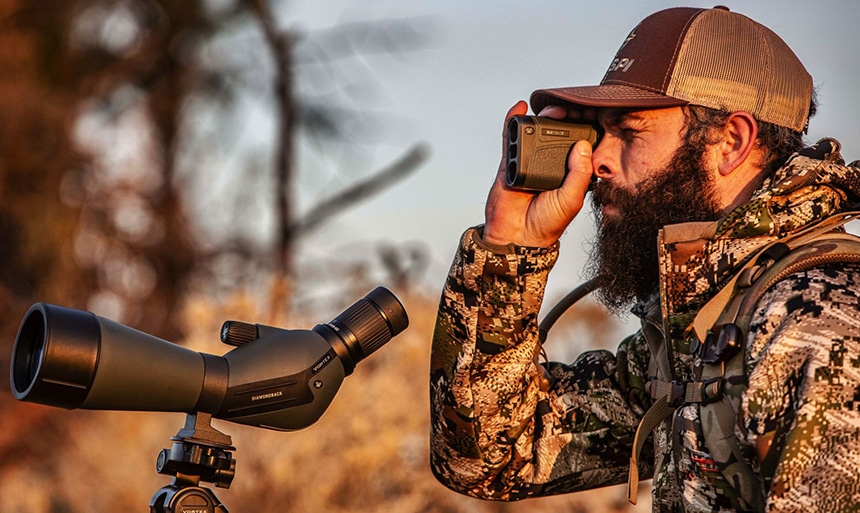
Are you a novice when it comes to selecting a rangefinder for long range shooting? Have you been shooting for a while and want to expand your kit by adding a rangefinder? If you’ve answered “yes” to one or both of these questions, you will find the information below very useful.
Before rushing out to buy a rangefinder, you should consider the features you need to look out for. It’s important to remember that not all rangefinders are the same.
How important range is to you depends on whether you want to hunt over a long range or use it for other activities that don’t require long distance features. Most amateur hunters admit they will never use a range of 500 yards. Occasionally, they might go up to 800 yards maximum. Anything above that and you’re stepping into advanced hunting or sniper territory. The rangefinders snipers use ordinarily fall into the 1000-yard laser range finger category.
Therefore, for an average rifle hunter, a range of 200 – 800 yards is adequate. If you’re going to use your rangefinder for golfing, you’ll be looking at a range of 200 – 600 yards. A standard rangefinder that we’ve reviewed, the Nikon Prostaff 1000i 6×20 has a total range of 1000 yards, so it will suffice for all these uses.
If you are a specialised hunter needing the best 1000 yard rangefinder, you’ll be looking at the Leica Rangemaster CRF 2800.COM which has a total range of 2800 yards. The Leupold RX-2800 also has a total range of 2800 yards. Both of these rangefinders feature on our review list.
When it comes to accuracy, it’s important to note that the manufacturer will usually provide you with range accuracy that’s been measured under ideal conditions. The image you see is based on the size of the target as if it were under perfect conditions. Product specifications will break down the target accuracy into three sections.
For instance, reflective target will be 1000 yards, deer 500 yards and trees 800 yards. First time rangefinder users might be confused and focus on the 1000 yards and believe that is how far they’ll see the animal they want to shoot. It’s important to check the number of yards to animal. An example of this on our review list is the Leupold RX-2800. It has a total range of 2800 which breaks down to 1300 yard to tree, and 1100 yard to animal.
One of the most important features to take into consideration is magnification. Most models have a 4x – 6x magnification capacity, but it is possible to get high end models that can even offer 10x magnifications. For the most part, snipers are the only ones who really have a use for magnification of 10x and you’ll easily find this feature on a sniper laser range finder.
For normal hunting, like going after deer, a 6x magnification is more than adequate. On our review list, both the Leica Rangemaster CRF 2800.COM and the Leupold RX-2800 have a magnification range of 7x. The Bushnell Prime 1700 and Nikon Prostaff 1000i both have a magnification of 6x. The Sig Sauer KILO1000 with all its nifty features, only has a magnification of 5x so most buyers will prefer the Leica or Leupold.
Simply put, the larger your objective diameter, the higher the resolution and the brighter the image. The front lens is called the objective and is measured in millimeters (mm). This figure is generally shown at the second figure in a scope configuration. An example of this would be a 4×32 scope which then means there’s a magnification of 4x and a diameter lens of 32mm.
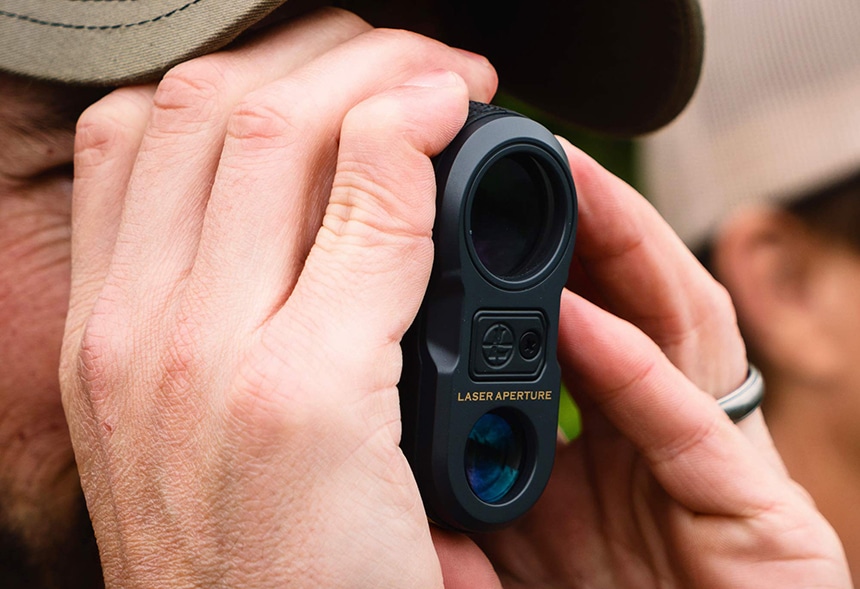
Eye relief is as important to understand and consider as it is in any other optical piece of equipment. It can simply be defined as the distance from the eye piece to the entrance of the pupil of the eye. This means it’s the measurement of how far your eyes should be from the lens for you to get the entire image.
Eye relief gives you the clearest and most realistic version of what you’re seeing. Here you want to look for higher eye relief and because this feature varies between models and brands, it’s important to test a few options to see what suits you best. On our review list, the Sig Sauer KILO1000 5×20 has an eye relief of 18mm, making it an ideal option for maximum clarity.
Standard on most rangefinders is a mode called scan mode. It’s a useful tool to note changes on moving targets and to familiarize yourself with the landscape around your possible target.
Other modes include first and second mode. First target mode refers to ranging smaller objects in close distances. If you range more than one distance, the first target mode will provide you with the distance of the nearest object.
Second target mode refers to long distance and background ranging. This mode will ignore the objects and distractions in the foreground, giving you readings on the furthest targets.
Ideally, you’d want a rangefinder with all three modes. A point to note here is that different brands might use different terminology to label these modes, but they are the same function.
Ideally, rangefinders should be comfortable to hold without tiring out your hand. You don’t want to carry around a big, heavy piece of equipment. Some rangefinders are small enough to fit onto the scope of a rifle. One such example is the ATN ACMUABL1000, which only weighs 0.8lbs and screws onto the scope with one easy turn.
The last thing you want to do is spend money on a decent long range rangefinder only to have the battery run flat two hours into your hunting session. Check the type of battery and also how long the specs estimate it to last. Here you’re looking for maximum battery life in continuous use as you are more than likely not going to be switching it off every 10 minutes.
Generally, rangefinders have reasonably adequate CR2 batteries. Once you’ve made your purchase, invest in additional batteries and add them to your kit. Ideally you should test your rangefinder’s battery life before you go hunting so that you know what to expect. The ATN ACMUABL1000 on our review list has 12 hours of continuous battery life, making it a crowd favorite.
When it comes to durability, you need to consider the environment in which you’re going to use your rangefinder. It it’s for hunting, you will obviously need a device that is tough so that it can withstand knocks and bumps. On our review list the Leupold RX-2800 has an aluminum casing making it more durable than most other rangefinders.
It’s also important to check that your rangefinder is fog proof and water proof or water resistant. Remember there is a difference between ‘water proof’ and ‘water resistant’. Water proof means your rangefinder won’t get damaged if it falls into the water.
Water or weather resistant means you can use your rangefinder in unpleasant weather conditions like rain or snow. Usually these units have seals on the parts that open like the battery casing. These seals protect the rangefinder against the elements.
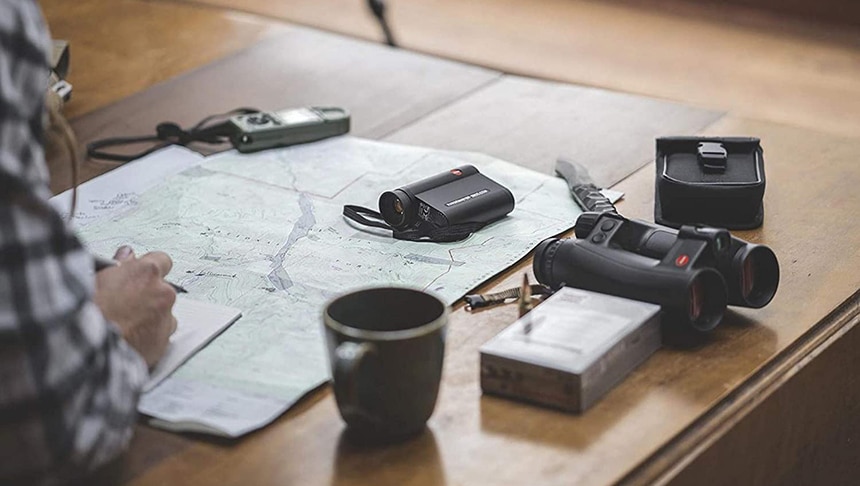
The period of warranty a manufacturer puts on their product is an indication of the confidence they have in the item. This helps you make better choices when shopping for the best investment. If a product only has a six-month warranty as opposed to a counterpart that offers a two-year or even lifetime warranty, what does that say about the item?
Bushnell rangefinders have a lifetime warranty whereas ATN ACMUABL1000 offers a two-year warranty. A point to remember here is to make sure you have clarity regarding what exactly is covered by the warranty. Will the item be repaired or replaced if something goes wrong? Understanding this process will ensure that you don’t have any unforeseen costs down the line.
The advancement of modern technology means there are a variety of new and exciting extra features that make rangefinders anything but ordinary. Some of these extra features are just nice to haves and others can really make a difference to your hunting experience. It’s important to establish which features you’d actually be using so you don’t spend on components you’ll never use.
Some of the interesting features to look out for include the following:
– Bushnell Prime 1700 on our review list offers the Brush and Bullseye which ignores objects in the foreground, giving your maximum clarity.
– The Sig Sauer KILO1000 has SpectraCoat anti reflection coatings that offer superior light transmission and enhanced optical images.
The additional features you want to look out for are the ones that enhance your ranging and give better clarity.
Prices of rangefinders vary depending on the features that each one has. It’s important to establish what features you will need and then source the prices relating to a unit with those specifications. To give you an idea of the different price ranges, consider that the Bushnell Prime 1700 retails for around $155 and the Nikon Prostaff can be yours for almost $200. At the other end of the spectrum we have the Leica Rangemaster which retails for over $10. So, whatever your budget is, chances are there’s a quality unit out there for you.
In our review we highlighted the feature we liked most is the multi-coated optics which heighten light transmission in different low light settings. See our review above for a more in depth analysis of the features.
Have you given some thought to which rangefinder you’ll be investing in? To help you choose the one that’s right for you, let’s outline what we’ve enjoyed about our top 3 pics the most.
Our editor’s choice, the Vortex Impact, with a rating of 9.5 is popular because not only does it have three different ranging modes, but it’s user friendly and great for beginners.
Second on our list of recommendations is the Nikon Prostaff 1000. Earning itself a rating of 9.2, and labeled our Best Value pick, we were impressed with this unit because of its Tru-technology feature. This one is tops in the Nikon 1000 yard rangefinder range.
The third option on our list of favorites is the Sig Sauer KILO 1000. As our Budget pick it rates 9.0. This long range shooting rangefinder is impressive because of its SpectraCoat anti-reflection technology offering the user superior light transmission.
We hope our reviews and buyers guide has given you a few options to consider when choosing the best rangefinder for long range shooting.
